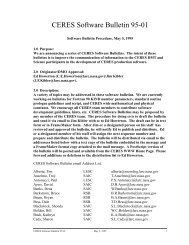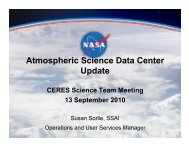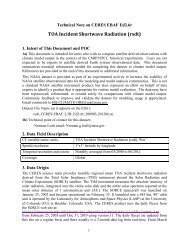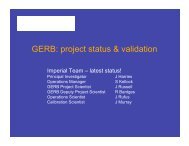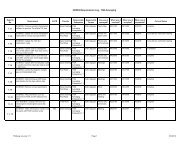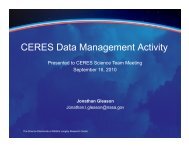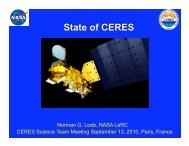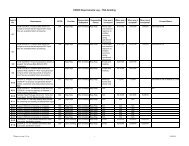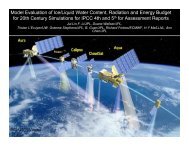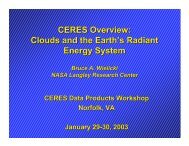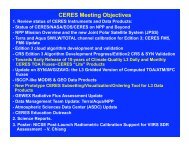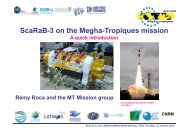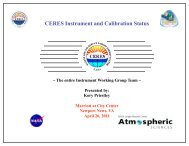Using TOA fluxes by cloud type to evaluate the ... - ceres - NASA
Using TOA fluxes by cloud type to evaluate the ... - ceres - NASA
Using TOA fluxes by cloud type to evaluate the ... - ceres - NASA
You also want an ePaper? Increase the reach of your titles
YUMPU automatically turns print PDFs into web optimized ePapers that Google loves.
<strong>Using</strong> <strong>TOA</strong> <strong>fluxes</strong> <strong>by</strong> <strong>cloud</strong> <strong>type</strong> <strong>to</strong> <strong>evaluate</strong> <strong>the</strong> CanAM4<br />
Jason Cole<br />
Canadian Centre for Climate Modelling and Analysis (CCCma)<br />
Environment Canada, Toron<strong>to</strong><br />
Howard Barker<br />
Cloud Physics and Severe Wea<strong>the</strong>r Section,<br />
Environment Canada, Toron<strong>to</strong><br />
Norman Loeb<br />
<strong>NASA</strong> Langley<br />
Knut von Salzen<br />
Canadian Centre for Climate Modelling and Analysis (CCCma)<br />
Environment Canada, Vic<strong>to</strong>ria<br />
Jason.Cole@ec.gc.ca<br />
www.cccma.ec.gc.ca
Zonal annual mean <strong>cloud</strong> fractions
Top of atmos. <strong>cloud</strong> radiative effect (CRE) (2000-2009)<br />
CRE=clear-sky flux – all-sky flux<br />
Dataset: CERES EBAF<br />
-95 W/m^2 95 W/m^2
Is <strong>TOA</strong> <strong>cloud</strong> rad. effect consistent with liq. water path?<br />
Annual mean liquid water path averaged<br />
over 1988-2007.<br />
CanAM4 is much larger in mid-lat s<strong>to</strong>rm<br />
tracks. Why isn't reflected solar <strong>to</strong>o large?<br />
Dataset: O'Dell, J. Climate, 2008<br />
0 g/m^2 250 g/m^2
Compensating biases in <strong>cloud</strong>s<br />
Zhang et. al., 2005; 60S-60N<br />
DJF, 2001-2002<br />
CRE=A(F clr<br />
-F cld<br />
)
Radiative effects <strong>by</strong> <strong>cloud</strong> <strong>type</strong><br />
Hartmann et. al., 1992 => ERBE and ISCCP<br />
“We believe it will be important <strong>to</strong> verify that <strong>the</strong> net <strong>cloud</strong> radiative forcing <strong>by</strong><br />
individual <strong>cloud</strong> <strong>type</strong>s (simulated in GCMs) is as observed, as well as <strong>to</strong> verify<br />
that <strong>the</strong> <strong>to</strong>tal <strong>cloud</strong> forcing is realisitic.”<br />
Net <strong>cloud</strong> forcing
Radiative effects <strong>by</strong> <strong>cloud</strong> <strong>type</strong><br />
Hartmann et. al., 1992 => ERBE and ISCCP<br />
Chen et. al., 2000 => ISCCP + radiative transfer calculations<br />
Webb et. al., 2001 => daily ERBE and ISCCP (July 98)<br />
Cali. Sc region
Radiative effects <strong>by</strong> <strong>cloud</strong> <strong>type</strong>: CERES and MODIS<br />
Clear-sky<br />
Cloudy-sky<br />
Variables observable from<br />
CERES+MODIS<br />
Case of M=3 with vertical<br />
boundaries matching ISCCP
An example from a CloudSat/CALIPSO cross-section<br />
Complete dataset (<strong>cloud</strong> props + radiation) give more information<br />
Uncertainity about underlying <strong>cloud</strong>s due <strong>to</strong> passive observations<br />
- active observations are needed for profile info
Compensating biases in <strong>cloud</strong>s: CanAM4 Results<br />
July 2001-2005 60°S-60°N<br />
Cole et. al., J. Climate, 2011
Relation between albedo and <strong>cloud</strong> fraction (July 1998)<br />
All clr sky<br />
All cld sky<br />
Webb et. al., 2001
Daily mean variations in albedo and <strong>cloud</strong> fraction<br />
July 2001-2005 60°S-60°N
Summary<br />
• Time mean <strong>cloud</strong> and radiation properties are similar <strong>to</strong> observations<br />
- Use of simula<strong>to</strong>rs aid in comparisions<br />
- Several of <strong>the</strong> biases are known and some are similar <strong>to</strong><br />
o<strong>the</strong>r models<br />
• Supplement passive <strong>cloud</strong> properties with <strong>TOA</strong> radiative <strong>fluxes</strong> <strong>by</strong> <strong>cloud</strong>-<strong>type</strong><br />
- There are time-mean biases that are consistent with our<br />
expectations<br />
- Time means are realized in ra<strong>the</strong>r different ways wrt<br />
observations<br />
• Fuller evaluation of CanAM4 using <strong>the</strong> new flux <strong>by</strong> <strong>cloud</strong> <strong>type</strong> dataset



